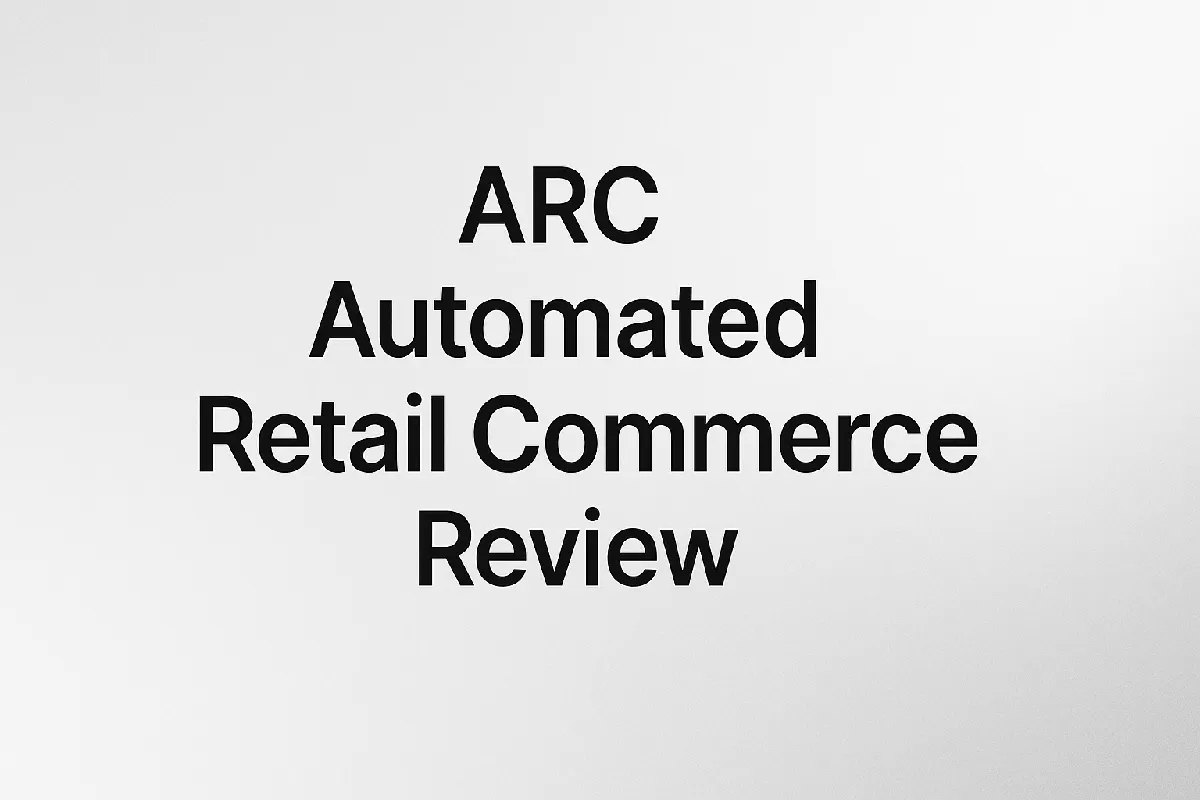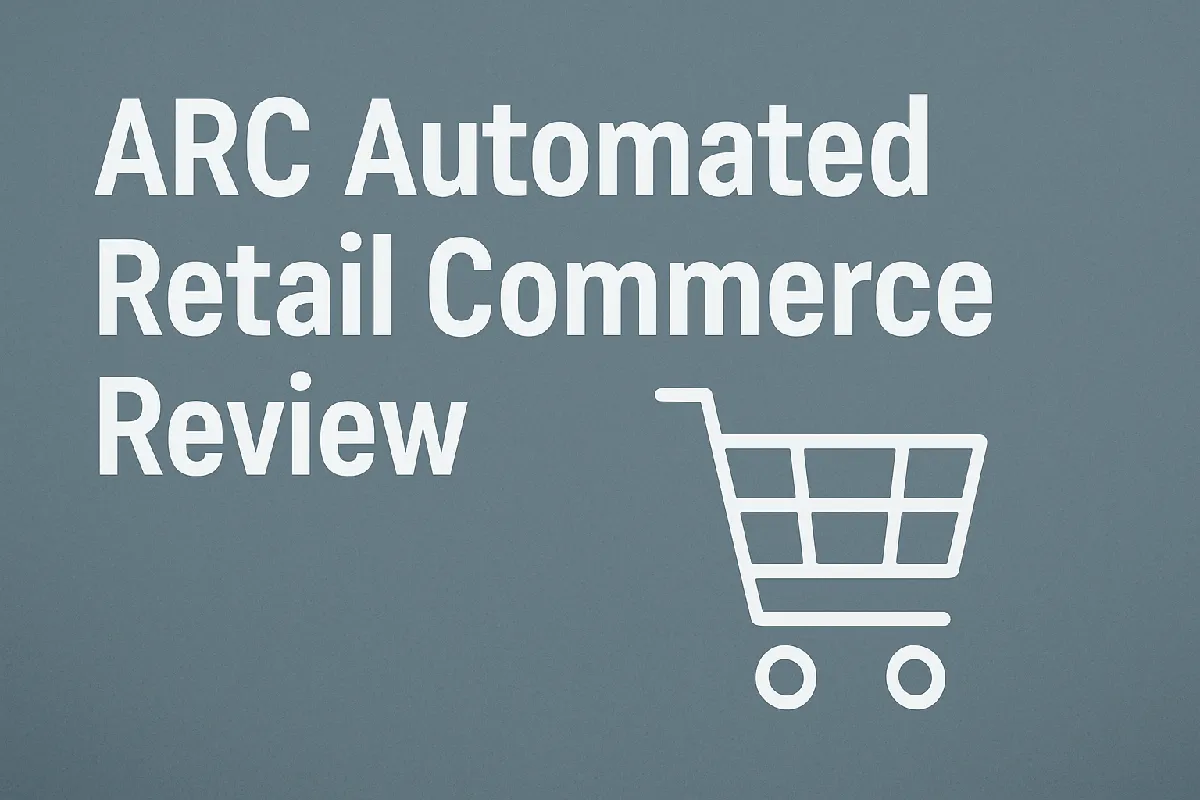Automated Retail Commerce Review - What to Expect From ARC?
Welcome to this Automated Retail Commerce review. ARC is a done-for-you e-commerce service that builds and manages online stores for clients.
It looks appealing because it takes away the need to handle product sourcing, store setup, and daily operations yourself.

They even claim to get stores launched within a couple of weeks and scale them using their “proven processes.”
The reality I found was more complicated. The service comes with a high upfront investment, ongoing costs, and plenty of risk tied to how platforms like Amazon enforce their rules.
Many client reports suggest inconsistent results, with some stores performing for a while and others being shut down altogether.
Adding to the uncertainty, ARC recently shifted all operations to another company, which leaves open questions about accountability moving forward.
Pros
Done-for-you structure removes technical barriers
Clear process for sourcing and launching products
Potentially good for those who want a hands-off model
Cons
High upfront and recurring costs
Numerous reports of stores being suspended
Poor refund experiences from past clients
Operational shift raises stability concerns
If you’ve ever wondered why so many done-for-you e-commerce models sound simple but often fall apart in practice, there’s a breakdown worth reading here.
What is ARC Automated Retail Commerce?
The company presents itself as a done-for-you e-commerce provider that sets up and manages online stores for clients.
The idea is simple: instead of learning product research, supplier outreach, and platform rules, you invest capital and let their team handle the moving parts.
Their messaging emphasizes speed, with claims that stores can be launched in as little as two weeks.
They also promote the use of processes they say have generated significant revenue across multiple accounts.
The pitch is that clients get access to a system designed to compound results over time, without needing to run operations themselves.
A recent shift added another layer of complexity. All existing contracts and responsibilities were moved from the original company to a different entity.
That kind of transfer isn’t necessarily unusual in this space, but it does leave open questions about accountability and how consistent the support will be going forward.
Overall, the service positions itself not as a training course, but as a turnkey way to enter e-commerce.
The appeal comes from skipping the trial-and-error phase and relying on a team that claims to already know what works. Whether that actually plays out for clients is another story.
My Personal Experience With Automated Retail Commerce

When I first looked into this service, what stood out most was the promise of convenience.
The idea of skipping the grind of product research and supplier hunting sounded appealing.
I’d already spent time trying to build stores on my own, and the thought of handing those responsibilities over to a team with a structured process felt like a possible shortcut.
The onboarding was polished enough, but once things moved past the setup phase, the cracks started to show.
Communication wasn’t always consistent, and updates on progress came slower than expected.
Instead of feeling like I was in control of an asset, I often felt like I was in the dark, waiting on someone else to let me know what was happening behind the scenes.
The results were mixed. Some products moved quickly, and for a moment it looked like the system might scale the way it had been described.
But then I saw orders stall out, returns increase, and profit margins shrink once fees and subscription costs were factored in.
What started as excitement shifted into a constant calculation of whether the investment was worth keeping.
The biggest frustration came when I tried to get clarity on performance. Questions about why sales slowed down or why certain products were chosen didn’t always get answered directly.
That lack of transparency made me uneasy, especially considering how much capital was tied up in the process.
Looking back, the experience taught me that handing over control doesn’t necessarily remove the stress — it just changes where the stress comes from.
Instead of worrying about finding products myself, I was worrying about decisions I couldn’t see or influence.
What I learned is that the real challenge isn’t just running the store — it’s figuring out why the results rarely line up with what’s promised. If you’ve noticed that same pattern elsewhere, there’s an explanation for that. You can find it here.
How Much Does Automated Retail Commerce Cost & What's The Refund Policy?
The investment required to get started wasn’t small. In my case, it involved an upfront payment paired with recurring monthly fees for management.
What stood out quickly was that this wasn’t just a one-time cost — the ongoing subscription meant I was under constant pressure to see sales that covered it.
What made things even more confusing was the lack of consistency around what people were actually charged.
Some client reports I came across mentioned paying as much as $45,000 upfront, with the expectation that the store would be fully built and managed for them.
Others shared different numbers, including packages closer to $1,500 upfront plus a few hundred dollars per month.
That kind of wide gap in reported pricing left me wondering whether costs were changing over time or tailored based on how someone entered the program. Either way, it made me uneasy not knowing what the real baseline was.
The refund side of things didn’t make me feel much more secure. The way it was marketed suggested there was a guarantee if things didn’t work out.
But once I looked closer, the fine print was filled with conditions, and I found multiple accounts from clients who said they tried to claim refunds but were met with silence or delays.
I never personally went through the process, but knowing that others struggled to get their money back didn’t inspire much confidence.
Ultimately, the pricing wasn’t just high — it felt unpredictable. Pair that with a refund policy that looked good on the surface but shaky in practice, and it created a financial commitment that felt more like a gamble than a calculated investment.
ARC Student Results and Testimonials

When I started digging into other people’s experiences, what I found was a wide range of outcomes.
Some clients shared that their stores had quick wins in the beginning, moving products and showing early signs of growth.
A few even posted screenshots of sales figures that looked promising. At first glance, those results gave the impression that the model could deliver exactly what was being advertised.
But the more feedback I read, the more inconsistent the picture became. Alongside the positive stories were plenty of accounts from people who said their stores stalled out, or worse, were suspended by platforms like Amazon.
Some of these clients mentioned losing tens of thousands of dollars, with little to no recovery.
Others reported that the products being sold weren’t always aligned with marketplace rules, which led to headaches and account closures.
That contrast made it difficult to know what the “average” outcome really was. For every glowing testimonial, there seemed to be another review calling the whole thing a waste of money.
Even the timing of the results varied — some stores seemed active for a few months before slowing down, while others struggled almost from day one.
From my perspective, the mixed nature of these testimonials created more doubt than reassurance.
The success stories didn’t feel representative of what most people were going through, and the negative reviews raised enough concerns that I couldn’t ignore them.
It became clear that while some clients might hit on the right combination of timing and products, many others would end up with disappointing results.
Who is ARC Automated Retail Commerce Best For?
Looking back on my experience, this service didn’t feel like something designed for beginners testing the waters.
The barrier to entry was simply too high, both in terms of upfront cost and the ongoing subscription.
That alone makes it a poor fit for anyone working with limited resources or hoping to start small and scale later.
The model seemed better suited for people who already had disposable capital and were comfortable taking risks.
It appealed to those who wanted to bypass the steep learning curve of e-commerce and instead rely on a managed system.
In theory, that meant handing the work over to a team and treating the business more like an investment than a skill you build yourself.
That said, it didn’t seem like a great fit for someone who values transparency or wants to understand how their business actually runs.
A lot of the decisions — from product selection to platform strategy — happened behind the scenes.
If you’re the kind of person who likes control, this approach can feel frustrating because you’re left waiting for updates instead of actively steering the direction of the store.
It also became clear that this wasn’t ideal for anyone expecting quick or guaranteed results.
Even in cases where sales started off strong, there was no assurance they would continue.
The unpredictability, combined with recurring expenses, meant the best candidates were those who could absorb potential losses without it becoming a financial crisis.
In short, the service is aimed at people with capital, patience, and a willingness to surrender control — not those seeking a low-cost entry point or a reliable income stream.
Automated Retail Commerce Pros and Cons
There were some clear advantages to using this kind of service. The biggest benefit was not having to deal with the typical grind of e-commerce setup.
Tasks like product research, supplier communication, and listing optimization were all taken care of, which freed up time and reduced the overwhelm that usually comes with starting an online store from scratch.
For someone who doesn’t want to learn every detail of the business, having a structured system and a team running the operations did make the process feel more manageable.
Another advantage was the sense of speed in the early stages. The store was put together quickly, and for a brief period, sales started flowing.
That momentum created the feeling that progress was being made and that the investment might pay off.
For people who simply don’t have the time to immerse themselves in learning the ins and outs of e-commerce, this kind of managed approach has an undeniable appeal.
The downsides, however, were harder to ignore. The cost created constant pressure.
Even when sales happened, they didn’t always cover the monthly fees, let alone the initial outlay.
The unpredictability of results made it feel less like building a business and more like gambling on whether the system would deliver in any given month.
Transparency was another major issue. Important decisions were made out of sight, and updates weren’t always clear.
That left me in a position where I was investing heavily without really knowing how or why certain choices were made.
Combined with the number of client reports about store suspensions and refund disputes, it added up to a model that carried more risk than I was comfortable with.
Final Verdict
My overall impression of this service is mixed. On one side, it provided convenience that I couldn’t get from building a store on my own.
The setup was handled quickly, and I didn’t need to spend hours buried in product research or negotiating with suppliers.
For someone who values time and wants to bypass the technical side of e-commerce, there’s no denying the model has appeal.
But the trade-offs outweighed the benefits for me. The financial commitment was heavy, and the ongoing subscription created constant pressure.
Even when sales came in, they didn’t always balance out against the costs, which made the whole thing feel unstable.
It wasn’t the predictable stream of growth that the messaging suggested — it was more like a cycle of hope followed by uncertainty.
The lack of transparency also made me uncomfortable. Decisions were made behind the scenes, and communication wasn’t as open as I expected for something that carried such a high price tag.
Add to that the reports from other clients about stores being shut down and refunds being hard to secure, and it became clear this wasn’t a system I could rely on long term.
In the end, I see this less as a guaranteed path to success and more as a high-risk investment.
It might work for someone with extra capital and patience to handle volatility, but for most people looking for a stable way into e-commerce, it’s unlikely to deliver what they’re hoping for.
What this experience taught me most is that the biggest gap isn’t between building a store yourself or outsourcing it — it’s between what’s promised and what actually happens once you’re inside.
If you’ve ever wondered why that gap shows up so often, you’ll find a clear explanation here.